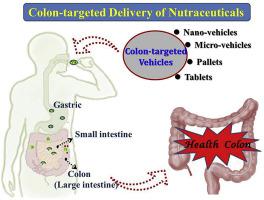Trends in Food Science & Technology ( IF 15.3 ) Pub Date : 2020-06-07 , DOI: 10.1016/j.tifs.2020.05.019 Kun Feng , Yun-shan Wei , Teng-gen Hu , Robert J. Linhardt , Min-hua Zong , Hong Wu

|
Background
Advances in nutriology have suggested the colon as a superior site for nutrition absorption. Nutraceuticals, including phytochemicals, probiotics, etc., have received great attention owing to their health-promoting functionalities for colon. However, these compounds generally exhibit poor solubility or are sensitive to the harsh environment of food processing and gastrointestinal tract, thus, lowering their bioavailability and compromising their envisioned benefits. Therefore, there is a need to develop suitable delivery systems to protect active agents from these severe conditions and to maintain their functions in the colon.
Scope and approaches
Colonic delivery of nutraceuticals has emerged as a new impetus for researchers interested in developing functional foods. This review presents an overview mainly about current studies relevant to different colon-targeted vehicles for nutraceuticals. The physiological conditions of colon and the corresponding principles for constructing vehicles are first reviewed to better understand the mechanisms of different vehicles. Relevant methods for evaluating the efficiency of vehicles are also summarized. Last, current limitations and the future scope for the colonic delivery of nutraceuticals are identified and addressed.
Key findings and conclusions
Recently, significant progress has been made in colon-targeted delivery of nutraceuticals and different evaluation methods were applied to assess the efficacy of vehicles. However, advances in the colonic delivery of nutraceuticals are still in their early stages and multi-unit vehicles with great efficacy need to be further investigated. Furthermore, to fully mimic the real conditions of gastrointestinal tract, more systematic and precise in vitro/vivo testing should be explored to make sure that a fully function of nutraceuticals enters the colon.
中文翻译:

以结肠为目标的营养保健品输送系统:综述当前的车辆,评估方法和未来前景
背景
营养学方面的进展表明,结肠是营养吸收的优越场所。营养食品,包括植物化学物质,益生菌等,由于它们对结肠具有促进健康的功能而备受关注。但是,这些化合物通常显示出较差的溶解性或对食品加工和胃肠道的恶劣环境敏感,因此降低了它们的生物利用度并损害了它们的预期益处。因此,需要开发合适的递送系统以保护活性剂免于这些严酷条件并维持其在结肠中的功能。
范围和方法
结肠保健食品的交付已成为对开发功能性食品感兴趣的研究人员的新动力。这篇综述主要概述了与针对营养保健品的不同结肠靶向载体相关的当前研究。首先回顾了结肠的生理条件和构建载具的相应原理,以更好地了解不同载具的机制。还总结了评估车辆效率的相关方法。最后,确定并解决了目前在结肠营养保健品中的局限性和未来范围。
主要发现和结论
近来,在结肠靶向递送营养保健品方面已经取得了重大进展,并且采用了不同的评估方法来评估赋形剂的功效。然而,营养保健品在结肠中的递送仍处于早期阶段,具有更大功效的多单元载体尚需进一步研究。此外,为了完全模仿胃肠道的实际状况,应探索更系统,更精确的体外/体内测试,以确保营养保健食品的全部功能进入结肠。



























 京公网安备 11010802027423号
京公网安备 11010802027423号